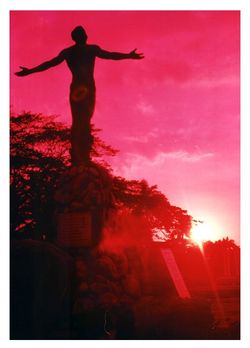Oblation Plaza: Difference between revisions
No edit summary |
|||
| Line 3: | Line 3: | ||
==The Symbolism of Oblation== | ==The Symbolism of Oblation== | ||
The Oblation is a concrete statue by Filipino artist [[Guillermo E. Tolentino]]. Depicting a man facing upward with arms outstretched, symbolizing selfless offering of oneself to his country, it serves as the iconic symbol of the [[University of the Philippines]]. | The Oblation is a concrete statue by Filipino artist [[Guillermo E. Tolentino]]. Depicting a man facing upward with arms outstretched, symbolizing selfless offering of oneself to his country, it serves as the iconic symbol of the [[University of the Philippines]]. | ||
{{UP Diliman}} | |||
==History of Oblation== | ==History of Oblation== | ||
Revision as of 17:14, 27 February 2009

Oblation plaza is a garden where the famous Oblation statue is located. It is in front of Quezon Hall at University of the Philippines, Diliman.
The Symbolism of Oblation
The Oblation is a concrete statue by Filipino artist Guillermo E. Tolentino. Depicting a man facing upward with arms outstretched, symbolizing selfless offering of oneself to his country, it serves as the iconic symbol of the University of the Philippines System.
History of Oblation
Then UP Fine Arts Professor, Guillermo E. Tolentino, made the Oblation, with the help of Anastacio T. Caedo, his student apprentice, who also served as the model for the sculpture. Caedo would later succeed Tolentino's post as Fine Arts professor after the death of his teacher.



